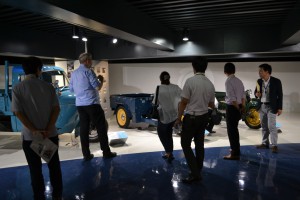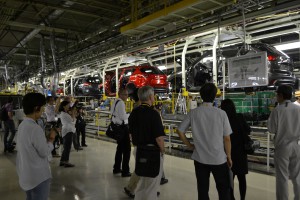Date : July 9 - 10, 2015
Report:Hiroshima Press Tour “70 Years After the War”
post date : 2015.07.27
The FPCJ and Hiroshima City jointly held a press tour to Hiroshima, with this year marking 70 years since the atomic bomb was dropped. Fifteen journalists from 11 countries and regions (the USA, Russia, France, China, Switzerland, Germany, Denmark, Spain, South Korea, Taiwan, and Singapore) participated in the tour. In addition to interviewing the mayor and hibakusha (atomic bomb survivors), the tour also covered new efforts to pass on the memories of the bombing and unique local businesses that have grown along with Hiroshima after the war.
Click here for tour details
Click here for real-time reports from during the tour
[Day 1]
1. Atomic Bomb Dome and Hiroshima Peace Memorial Museum
First, the tour met with Ms. Keiko Ogura, a hibakusha, in front of the Atomic Bomb Dome. Ms. Ogura was eight years old at the time of the bombing, and in 1984 she established Hiroshima Interpreters for Peace (HIP). For many years, she was worked as an interpreter helping foreign academics and journalists researching Hiroshima. The journalists gathered around Ms. Ogura while walking through the Peace Park, listening intently and taking pictures of her as she spoke about the memorials and her own experiences.
At the Hiroshima Peace Memorial Museum, Ms. Ogura explained the exhibits. In response to journalists’ requests to continue interviewing Ms. Ogura in the Peace Park, she graciously continued speaking for longer than originally planned.
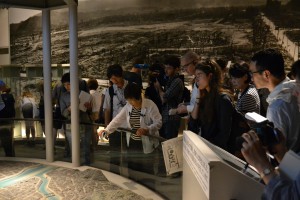

2. Interview with Hiroshima Peace Culture Foundation Chairperson Yasuyoshi Komizo
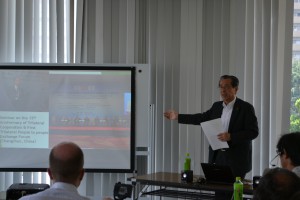 Next, the tour heard from Mr. Yasuyoshi Komizo about the role of Hiroshima as a city that suffered an atomic bombing, and about the Mayors for Peace. While showing a video of a girl who was five years old at the time of the bombing, he spoke of how inhumane atomic bombs are and the feelings of hibakusha fighting for nuclear abolition. One journalist mentioned a memorable phrase from Mr. Komizo’s statement was that “Possessing nuclear weapons cannot be a deterrent to nuclear weapons.” During the Q&A session, one of the questions was “This summer will mark 70 years since the atomic bomb was dropped. I understand there are a variety of activities in Hiroshima to ensure the memories are passed on, but are there ways in which this year will be different from before?”
Next, the tour heard from Mr. Yasuyoshi Komizo about the role of Hiroshima as a city that suffered an atomic bombing, and about the Mayors for Peace. While showing a video of a girl who was five years old at the time of the bombing, he spoke of how inhumane atomic bombs are and the feelings of hibakusha fighting for nuclear abolition. One journalist mentioned a memorable phrase from Mr. Komizo’s statement was that “Possessing nuclear weapons cannot be a deterrent to nuclear weapons.” During the Q&A session, one of the questions was “This summer will mark 70 years since the atomic bomb was dropped. I understand there are a variety of activities in Hiroshima to ensure the memories are passed on, but are there ways in which this year will be different from before?”
3. Interview with Hiroshima A-bomb Survivors’ Association President Sunao Tsuboi
The tour spoke with Mr. Tsuboi, who was 20 at the time of the bombing and continues to speak about his experiences and work as the president of the Hiroshima A-bomb Survivors’ Association. Mr. Tsuboi stood and spoke to the journalists for over two hours, telling them what it was like during the bombing, about the illnesses he has faced due to the bombing, and about the preposterousness of war. While speaking about what happened right after the bomb dropped, he spoke about how when a young girl grabbed onto an army truck that was rescuing young men, a soldier told her to get off, and the young girl walked off crying into the burning city. Speaking of this memory, Mr. Tsuboi said “War stole the hopes and dreams of young people. This will pain me until the day I die.” The journalists asked questions such as “70 years after the bombing, do you believe people in Japan and around the world are forgetting what happened in Hiroshima,” “How did you feel when you met with people from other countries that Japan caused suffering to,” and “Japan-US relations have changed significantly since the war, and they are now allied countries, but would you want the American president to come to Japan and apologize?”
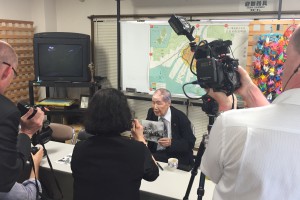

4. Interview with High School Peace Ambassadors
The High School Peace Ambassador Project sends high school students to the UN to call for bringing about a peaceful world and the abolishment of nuclear weapons. The tour interviewed two former high school ambassadors, Ms. Mami Kuwahara and Ms. Misaki Katayama, and this year’s peace ambassador, Ms. Tsugumi Inoue. When asking their reasons for applying to become a peace ambassador, Ms. Inoue, who will be going to the UN this year as a peace ambassador representing Hiroshima, said she decided to apply after hearing a hibakusha say “I would like to go speak to the UN right now, even if I have to get in a wheelchair to do it.”
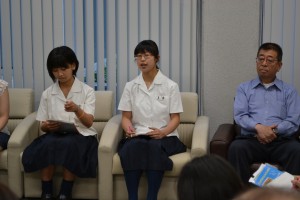 The journalists asked questions about what activities they did at the UN, the meaning of growing up in Hiroshima, and the future of Japan. Although they had to think about how to answer the difficult questions asked by the journalists, the interviewees all clearly presented their opinions with their responses. Ms. Kuwahara, who is currently studying at an American university, was asked questions such as “What do you think of the opinion that the atomic bombing was the right choice to end the war,” and “How have Americans opinions on the atomic bombing of Hiroshima changed after you spoke with them, and have you changed as well?”
The journalists asked questions about what activities they did at the UN, the meaning of growing up in Hiroshima, and the future of Japan. Although they had to think about how to answer the difficult questions asked by the journalists, the interviewees all clearly presented their opinions with their responses. Ms. Kuwahara, who is currently studying at an American university, was asked questions such as “What do you think of the opinion that the atomic bombing was the right choice to end the war,” and “How have Americans opinions on the atomic bombing of Hiroshima changed after you spoke with them, and have you changed as well?”
5. Otafuku Sauce Co., Ltd.
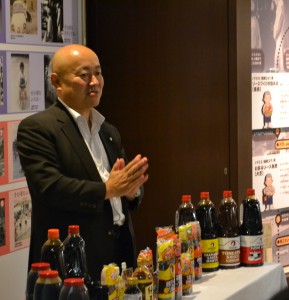 At the end of the first day, the tour visited Otafuku Sauce, famous for its okonomiyaki sauce. Upon arrival, the group was able to sample some okonomiyaki, and had the opportunity to watch and film a demonstration of how to make Hiroshima-style okonomiyaki. Next, the tour visited the Okono Museum, which has exhibits including a replica of the kind of food stand where okonomiyaki first became popular after the war. When interviewing Mr. Naoyoshi Sasaki, the grandson of the company’s founder, he spoke of the company’s history and how he was a second-generation hibakusha. The company has expanded its business overseas as well, leading to questions from journalists such as “Sushi is well known overseas, why isn’t okonomiyaki,” “What kind of people buy okonomiyaki sauce overseas,” and “What effect has the low value of the yen had?”
At the end of the first day, the tour visited Otafuku Sauce, famous for its okonomiyaki sauce. Upon arrival, the group was able to sample some okonomiyaki, and had the opportunity to watch and film a demonstration of how to make Hiroshima-style okonomiyaki. Next, the tour visited the Okono Museum, which has exhibits including a replica of the kind of food stand where okonomiyaki first became popular after the war. When interviewing Mr. Naoyoshi Sasaki, the grandson of the company’s founder, he spoke of the company’s history and how he was a second-generation hibakusha. The company has expanded its business overseas as well, leading to questions from journalists such as “Sushi is well known overseas, why isn’t okonomiyaki,” “What kind of people buy okonomiyaki sauce overseas,” and “What effect has the low value of the yen had?”

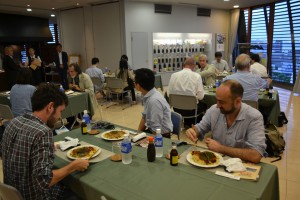
[Day 2]
6. Interview with a Successor to the Memories of Hibakusha
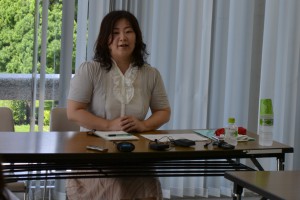 “There are some things that Mr. Kunishige (hibakusha) can’t speak about himself, but a third party can speak about. I believe we can speak about the pain and the burdens these hibakusha have carried.” These are the words of Ms. Minako Omatsu, who is part of a project to carry on the memories of hibakusha and pass on their experiences. Her three years of training will end next year, and she will act as a successor, speaking to students and others about the experiences of hibakusha. Ms. Omatsu spoke about why she resolved to participate in the project, why she choose to become successor to Mr. Kunishige’s memories, and what she wanted to tell the next generation. The journalists asked questions such as “Hiroshima is representative of peace in Japan, but there is also Okinawa in the south. What do you think of peace activism outside of Hiroshima,” “Are there any plans for successors to go overseas,” and “What kinds of feelings do you want to communicate as you pass on Mr. Kunishige’s memories?”
“There are some things that Mr. Kunishige (hibakusha) can’t speak about himself, but a third party can speak about. I believe we can speak about the pain and the burdens these hibakusha have carried.” These are the words of Ms. Minako Omatsu, who is part of a project to carry on the memories of hibakusha and pass on their experiences. Her three years of training will end next year, and she will act as a successor, speaking to students and others about the experiences of hibakusha. Ms. Omatsu spoke about why she resolved to participate in the project, why she choose to become successor to Mr. Kunishige’s memories, and what she wanted to tell the next generation. The journalists asked questions such as “Hiroshima is representative of peace in Japan, but there is also Okinawa in the south. What do you think of peace activism outside of Hiroshima,” “Are there any plans for successors to go overseas,” and “What kinds of feelings do you want to communicate as you pass on Mr. Kunishige’s memories?”
7. Interview with the Mayor of Hiroshima
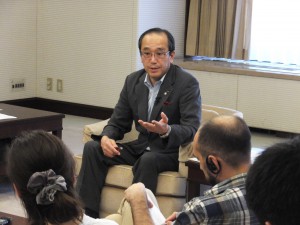 During the interview with Mayor Kazumi Matsui, he spoke about what message he wanted to send to the world on the 70th anniversary of the end of the war from Hiroshima, the first city to be atomic bombed, and about the issues being faced in attempts to pass on memories to the future. The mayor said that “If people come to Hiroshima, then they can understand how the pain of hibakusha is still continuing, and how inhumane nuclear weapons are,” and spoke about the feelings of the people of the city on nuclear abolition. Journalists asked questions including “How much is being spent on preserving buildings such as the Atomic Bomb Dome and on passing on memories,” “What do you think about the security bills,” “How do you deal with being protected by the USA’s nuclear umbrella,” “Tell us about your personal experience relating to the bombing,” and “What would you like to have global leaders do when they come to Hiroshima, and what have their reactions been like so far?” After the interview, some of the journalists mentioned how the mayor’s message made a strong impression.
During the interview with Mayor Kazumi Matsui, he spoke about what message he wanted to send to the world on the 70th anniversary of the end of the war from Hiroshima, the first city to be atomic bombed, and about the issues being faced in attempts to pass on memories to the future. The mayor said that “If people come to Hiroshima, then they can understand how the pain of hibakusha is still continuing, and how inhumane nuclear weapons are,” and spoke about the feelings of the people of the city on nuclear abolition. Journalists asked questions including “How much is being spent on preserving buildings such as the Atomic Bomb Dome and on passing on memories,” “What do you think about the security bills,” “How do you deal with being protected by the USA’s nuclear umbrella,” “Tell us about your personal experience relating to the bombing,” and “What would you like to have global leaders do when they come to Hiroshima, and what have their reactions been like so far?” After the interview, some of the journalists mentioned how the mayor’s message made a strong impression.
8. Hiroshima Electric Railway Co., Ltd.
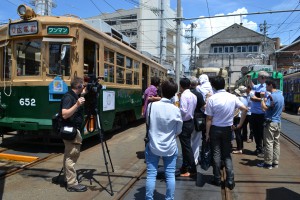 Two of Hiroshima Electric Railway’s streetcars that are still in service today have survived since the bombing. The tour visited the Hiroshima Electric Railway depot and filmed the streetcars that survived the bombing, while listening to an explanation from Mr. Koichi Higashi, chief of the Train Engineering Department. Journalists questions included “What kind of people were on streetcars at the time of the bombing,” “How many streetcars are running now,” and “What are your reasons for continuing to use to this day streetcars that were affected by the bombing?”
Two of Hiroshima Electric Railway’s streetcars that are still in service today have survived since the bombing. The tour visited the Hiroshima Electric Railway depot and filmed the streetcars that survived the bombing, while listening to an explanation from Mr. Koichi Higashi, chief of the Train Engineering Department. Journalists questions included “What kind of people were on streetcars at the time of the bombing,” “How many streetcars are running now,” and “What are your reasons for continuing to use to this day streetcars that were affected by the bombing?”
9. Mazda Motor Corporation
The tour ended with a visit to Mazda Motor Corporation, a company which is also successful in overseas markets. First, an overview was given of Mazda and its overseas business, as well as an explanation of its strategy in recent years and the company’s policy of craftsmanship. Next, a tour was given of the car production line in the factory, and there was an opportunity to take pictures as well. The Mazda Museum had exhibits displaying engines, various types of cars, and the three-wheeled truck that they restarted production of only four months after the bombing. Lastly, Mr. Yasuhiro Aoyama, an executive officer (general manager of Global Sales and Marketing), gave an interview. During the Q&A sessions, there were questions about the partnership with Toyota, the impact of Abenomics and the Chinese market, and the connection between Hiroshima’s history and Mazda.
